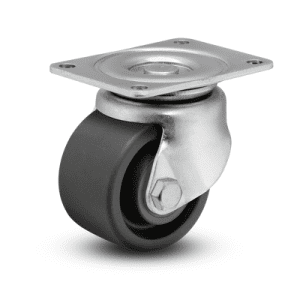 There are many important decisions you will need to make when deciding which type of caster to choose that’s ideal for your specific application. For versatile, heavy-duty applications it is likely your choice may come down to threaded stem casters, or top plate model casters.
There are many important decisions you will need to make when deciding which type of caster to choose that’s ideal for your specific application. For versatile, heavy-duty applications it is likely your choice may come down to threaded stem casters, or top plate model casters.
So, what are the characteristics of each, and the differences between them?
Threaded Stem Casters
Threaded stem casters have a threaded stem above the wheel housing. They are fixed directly into the object to which they are attached by this single thread – matching the threaded hole within the item, or are bolted on.
Such casters are extremely versatile. They are designed to add mobility to items of furniture, such as chairs, couches and tables. Threaded stem casters are typically designed with the screw thread on top so that they can be properly attached to equipment. You’ll find these types of caster on food service displays or institutional services equipment.
The main benefit of threaded stem casters is that they’re very easy to replace. If you have a caster that is cracked, broken or is just not rolling as it should, it can simply be unthreaded and repaired, or replaced by a new caster. These casters are also easy to clean and lubricate as needed.
When Should You Use Threaded Stem Casters
You use threaded stem casters in the workplace to reduce the amount of time that is spend transporting items. Having pieces of equipment on casters reduces the strain of moving items. One thing you will have to keep in mind about threaded stem casters is that they all swivel. If your application requires rigid casters, then threaded stem casters will not be an option.
If you work in areas where there’s a lot of loose debris, then you may find your casters becoming clogged with unwanted loose material. With threaded stem casters, it’s easy to keep them rolling smoothly with the application of a thread guard. This will prevent unwanted items from becoming stuck in the wheel bearings. Your casters will roll smoothly and a lot longer with the addition of threaded stem guards. They’ll also look better.
Top Plate Model Casters
A top plate caster consists of a wheel, an axle, and a plate. The plate usually doubles as the component that holds the axle and the wheel in place. The plate is usually square or rectangular, and has four screw holes – one in each corner. The caster can then be mounted on the item that it’s designed to add mobility to, via screws or bolts. Another option is to have the caster welded for more durable jobs.
The Benefit of Top Plate Model Casters
The main benefit of a top plate model caster is stability. Because the plate usually forms part of the wheel housing and because the plate has a larger surface area than a threaded stem, the caster is extremely stable and will provide excellent mobility. Additionally, if fixed by screws the work of the caster is supported across four separate points, as opposed to the single point of a threaded stem caster.
Top plate model casters also tend to be cheaper than threaded stem casters. They can be found with both swivel and rigid capabilities.
The main disadvantage of a top plate model caster is that they are not easy to replace, especially if they have been welded on to the item that they are providing mobility for. If they have been bolted, then that makes their replacement a little easier, but not as easy as simply popping out a threaded stem caster and popping in a new one.
Which to Choose – a Threaded Stem Caster or a Top Plate Model Caster?
So, how do you make the final decision? It really comes down to a number of specific factors about the application and your available budget.
If you have flexibility in the ways in which you can mount your casters, and if you need to keep your monetary costs low, then you should always go for top plate model casters. You get that added flexibility in that top plate model casters are available in both swivel and rigid varieties, plus they are generally more cost-effective than threaded stem casters.
Top plate model casters come in all types of plate sizes, and the larger the plate, the greater the work the caster can perform. This also means that you can choose a plate size that will give you the most stable mounting base that you want. Don’t forget that for added strength you can weld your top plate model casters in order to mount them. If it’s more convenient, then you can simply affix them using four bolts.
So to The Winner Is?
It seems then that top plate model caster comes out on top here, but that’s not necessarily the case for all applications. If space is at a premium – such as at the end of a table leg, chair or bench for example, then a threaded stem caster will likely be your best option. Don’t forget you may also be limited by the how the caster is attached to your item – either by a threaded hole or by a secured bolt. If you cannot attach your caster using any of these methods, then a grip ring stem caster is another viable alternative.
If you need more information about threaded stem casters or top plate model casters, then the team at Douglas Equipment will be happy to help. You can speak to any member of our team of caster experts by calling us toll free at 800-451-0030. If you’d prefer you can also contact us through our online contact form here.




